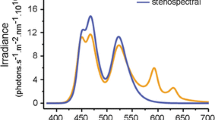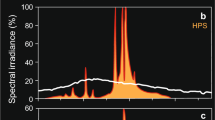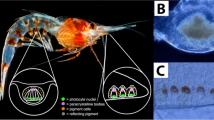Abstract
The plainfin midshipman Porichthys notatus Girard occurs in nearshore waters off the western coast of North America. We found that the ventrally directed photophores of juvenile laboratory-grown P. notatus function in counterillumination. Their bioluminescence matched downwelling light to obscure the silhouette as viewed from below. P. notatus did not obligatorily counterilluminate at all times in appropriate light. A hydrodynamic stimulus, in addition to appropriate downwelling light, was required to induce counterillumination. This is perhaps an adaptation to conserve its Vargula-type luciferin, which is obtained from its diet. The angular distribution of light produced by P. notatus approximated that typical of downwelling light in the ocean. There was a direct relationship between downwelling irradiance and the maximum intensity of P. notatus luminescence. Insufficient light was produced to replace the light blocked by the fish under lighting conditions typical of the natural environment. The luminescence was, however, effective in eliminating the silhouette of P. notatus as observed with an image-intensifying camera and by dark-adapted human observers. Consequently, the effectiveness of counterillumination probably originates in part from the disruptive pattern of the luminous photophores. P. notatus from the Puget Sound population, which lacks a luciferin source and is non-luminous, displayed counterillumination behavior when its luminescent system was activated by force-feeding the fish with dried Vargula hilgendorfi. Experiments using adult P. notatus as predators on a mixed population of non-luminous (Puget Sound) and luminous (Santa Barbara Channel) juvenile P. notatus revealed that under conditions of dim overhead illumination non-luminous P. notatus were preyed upon at twice the rate of luminous individuals. This is the first experimental evidence suggesting that counterillumination is effective as an anti-predatory strategy.
Similar content being viewed by others
Author information
Authors and Affiliations
Additional information
Received: 25 August 1998 / Accepted: 25 March 1999
Rights and permissions
About this article
Cite this article
Harper, R., Case, J. Disruptive counterillumination and its anti-predatory value in the plainfish midshipman Porichthys notatus. Marine Biology 134, 529–540 (1999). https://doi.org/10.1007/s002270050568
Issue Date:
DOI: https://doi.org/10.1007/s002270050568




